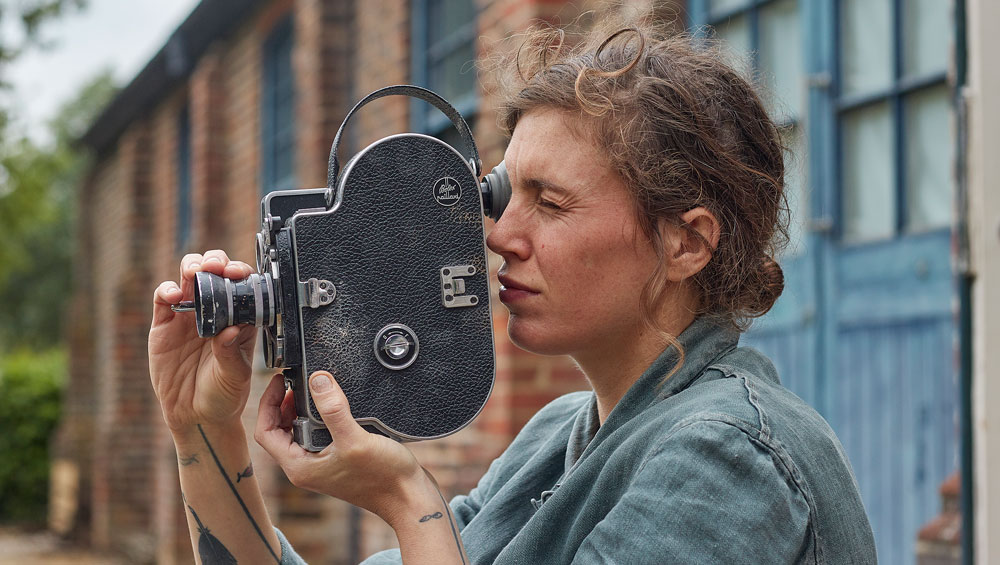
by ROSANNA MCLAUGHLIN
It is a cold, clear day in early summer and I am standing by a wood-fire kiln in the beautiful grounds of Cass Sculpture Foundation in Sussex, beside the Canadian artist Tamara Henderson (b1982). Behind us is a small wood, and in front of us is a table full of earthenware objects, which Henderson is preparing to fire with the help of a ceramic whizz named Alison Sandeman, who tutors at nearby West Dean College.
Like plans made in dreams, each of Henderson’s clay objects appears to be designed with a purpose that lies just beyond waking comprehension. In one corner of the table, a variety of odd-looking tubes spring from a sphere; in another, a small staircase (or is it a spine?) appears to emerge from a wonky box. This is perhaps only to be expected of an artist who uses hypnotherapy to come up with her ideas.
Since 2016, Henderson has been exhibiting various manifestations of Seasons End: a part-film, part-performance, part-installation project that follows the evolution of a cast of portentous and surreal characters. Along the way, Seasons End travelled to REDCAT in Los Angeles (2016), the Rodeo Gallery in London (2017), Oakville Galleries in Canada (2017), and the Serpentine in London (2017), culminating in an exhibition at Douglas Hyde Gallery in Dublin (2018).
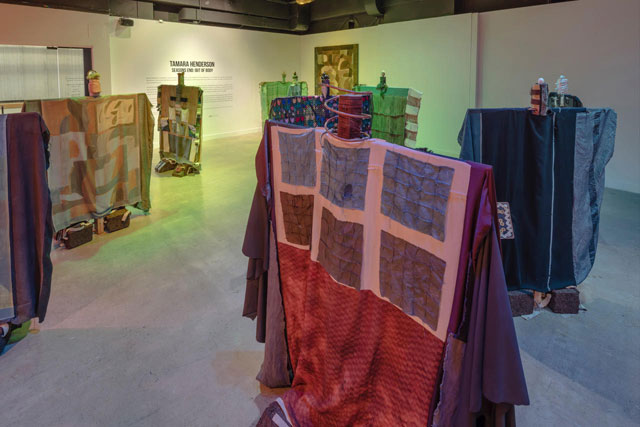
Tamara Henderson. Seasons End: Out of Body, 2016. Installation view at REDCAT, Los Angeles. Courtesy of the artist and Rodeo, London. Photograph: Brica Wilcox.
When we meet, Henderson is embarking on a new body of work, facilitated by her Cass Projects kiln residency. Buffeted by the Sussex winds, we discuss the transmigration of the soul, the transformative properties of clay, and the uses of art as a method for mourning.
Rosanna Mclaughlin: Can you describe what the ceramic objects in front of us are?
Tamara Henderson: On these tables there are about 35 clay body parts waiting to be fired. There are shins, feet, parts of a spine, parts of a shoulder, brain, breasts, thighs, a heart. It’s all disjointed right now, but the entire thing makes up a body and, when assembled, it will flow with water. So, we start with the brain, which has 35 outlets. The water will drip down through the brain to the eye, which then meets the mouth. Liquid will flow through the whole thing when it’s compiled. I’m showing the work first of all at Art Night in London, in July, which is curated by the Hayward Gallery, and then I’m taking it to the Geneva Biennial of Moving Image in November.
RM: Today, are you glazing the pieces in preparation for a final firing?
TH: In four days’ time, we will start firing early in the morning. Then, the parts have to be exposed to the correct temperature for 12 hours in order for the clay to go through the necessary transformative process. The objects you see here have already been bisque-fired. It’s been amazing building them from raw clay and being able to come back and hold them when they’re hard like this. Before, you couldn’t move them because they were too delicate. I learned how to wedge and extrude the clay, and I really felt the emergence of these defined body parts through the transitions of clay’s own materiality.
RM: It is a really complicated piece of ceramic engineering, with so many components and connecting parts. Did you make a maquette first to test it out?
TH: I don’t work like that. I work automatically, with the material. Although perhaps you could say “the maquettes” were the hypnotherapy I did at Gatwick airport.
RM: You did a hypnotherapy session at Gatwick airport? How did that occur?
TH: Marcos Lutyens, who did the induction at Gatwick, works with hypnotherapy and he’s also an artist. He was travelling from Riga to Los Angeles, and he had a stopover in London, so we met at a hotel in Gatwick just for a few hours. He was wearing this beautiful shepherd’s outfit. I had brought some clay with me, and we spoke a lot about the material and my intentions behind developing a relationship and a vocabulary with it, behind pulling something from the almost-earth into a form.
We did an induction that used the vocabulary around some of the textures and earth qualities where I’m from in New Brunswick. We spoke about the Bay of Fundy, and the pull and the push of the ocean, and the mud underneath the ocean. The Bay of Fundy is where the Atlantic Ocean comes in, and the highest tides in the world are there. When I was younger, I would go to the cape and, underneath, there’s this mud that gets darker and thicker when the tide goes out: many things are fossilised under there. The induction was 30 minutes long and it focused on this mud.
RM: Can you explain what an induction is?
TH: An induction is when you are held in a suspended state for a period of time. A hypnotic induction gives you a trance state, like a theta-rhythm state, where your body is heavy and relaxed so you don’t think about your body or moving. You’re lying down in a corpse pose, and listening to the suggestions of the person who is talking to you.
RM: And this is what you were doing at the hotel at Gatwick airport?
TH: Yeah, you can rent rooms by the hour. It was a really weird room: it had a large landscape window and, outside, it was totally grey and concrete. Aeroplanes were taking off all the time, so we had that in the background. Marcos acknowledged the sound during the induction, using a metaphor to make sense of it. He said to me: “You will notice every once in a while the sound of an aeroplane: these are your thoughts travelling and your mind becoming calmed.” It was a way of turning that sound into white noise so it doesn’t disturb. Like your breath, it’s just a noise.
RM: Did you record the induction?
TH: I used hypnotherapy a lot in my previous work when I was making furniture, but this is the first time I have recorded the induction. I return to that recording frequently. I just love listening to Marcos’s suggestion of a body in transformation: returning to deep under the mud, under the clay, transforming into clay, into a form, emerging and then entering the kiln, which is like a womb, and then the fire turning you into something hard, so that something that was soft is now rigid. When I was in London, I was going to a sensory deprivation tank and listening to the recording under water. I bought an underwater player just for the experience – it was really nice to get so deep.
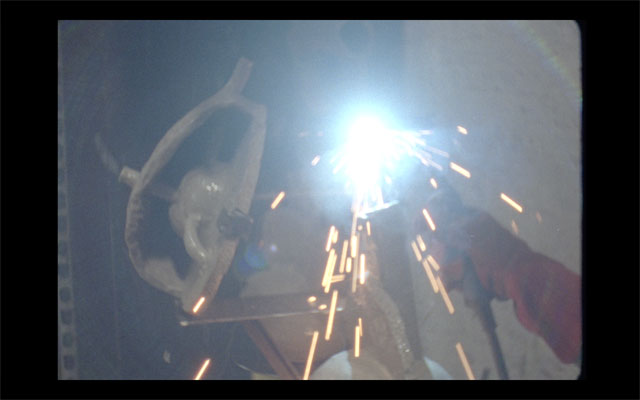
Tamara Henderson. Stills from Womb Life, 2018. 16mm colour film. Courtesy the Artist and Rodeo, Athens/London.
RM: Did the induction leave you with a fully formed idea of what the artwork would be, or something more like a roadmap, a set of directions for travel?
TH: The body parts were built using sense: sense of the material. I was thinking of what my senses are – my nervous system, my fascia – and extending myself into a material that is possible to form. Obviously, when it comes to the more systematic parts of the structure, for instance the tubes for the water, the design had to be practical and functional, but these requirements also worked as starting points.
RM: Earlier, you mentioned that the body will flow with water. What happens when the water reaches the bottom of the body? Will you use a pump system to circulate it back to the brain?
TH: At the [Art Night at New Covent Garden] flower market, there will be a 10-hour durational performance, and I am also making a film. During the performance, the water will be manually interacted with. Later, when it’s shown in a gallery – when it’s left to be a sculpture on its own and it’s not to be engaged with or interacted with any more by a performer – it will have a pump.
.jpg)
Tamara Henderson. Vision 3, Flowering Transition, 2018. Durational performance at New Covent Garden Market, London. Curated by Hayward Gallery for Art Night 2018. Photograph: Christa Holka. Image courtesy of the artist and Art Night.
This clay body is one of a number of characters who will be in the performance. The working title for the character is The Source. I also call the process of making this particular work “language of mud”: that’s how I refer to it in my documentation archive. All the pieces will be assembled on a florist’s trolley, and they will be propped and supported by “furniture” – objects you use in ceramics to support the things you are firing in the kiln – and props used in Iyengar yoga. I go to the Iyengar Institute once a week, and there’s a whole closet full of beautiful wooden wedges and cubes that are used to hold the body in an aligned position. As in Iyengar, I need to align The Source’s body parts so that they are knowing of themselves, so they can flow through the tubes.
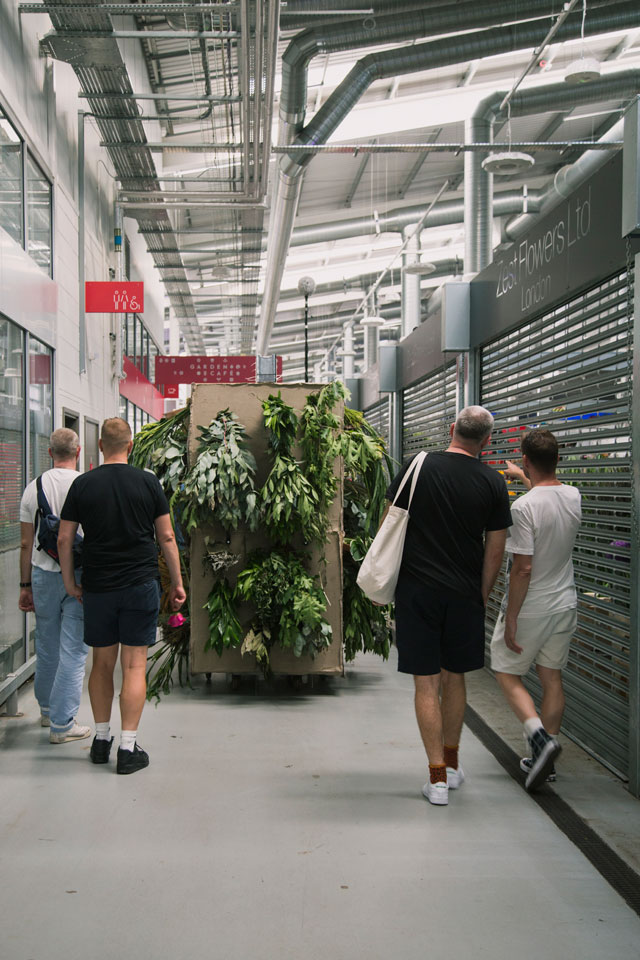
Tamara Henderson. Vision 3, Flowering Transition, 2018. Durational performance at New Covent Garden Market, London. Curated by Hayward Gallery for Art Night 2018. Photograph: Christa Holka. Image courtesy of the artist and Art Night.
RM: Do you consider the work you are making at Cass to be self-portraiture?
TH: I’m interested in the travelling of the spirit. I believe in transmigration, so I think it can be seen as a self-portrait of a spirit that’s appeared embodied at another time. During the induction, we were talking about thousands and thousands and millions of years ago when you were in the mud, maybe you were a trilobite or something like that. I’m interested in those realms and those spaces of energy that can bridge the gap between spirit and material matter.
RM: The medium of ceramics lends itself to transformations. The process of production can be really intimate, because the material is so malleable and in such close proximity to your hand and body as you work with it. Yet when it comes out of the kiln, it has its own solid definition, and is suddenly “other” to the maker.
TH: I have the feeling of “Who made this?” a lot working as an artist, especially when I’m painting. I paint automatically, using a method that is almost like meditation: I flow with time and colour. Sometimes, when I return to a painting, I wonder who painted it, and with the clay body I feel the same way.
RM: The Source is one of a number of characters who will feature in the performance at the flower market. Throughout your practice, characters, objects and forms reappear in different settings, often partially or fully transformed. You are also going to be recording the performance and later on producing a film. Can you describe the other characters?
TH: There will be The Eye, which is the camera. That’s my character, and it’s going to be outfitted with a microphone. The Eye is also an instrument of visual recording, mounted on a moving track so I can hit three solid points of perspective. The furniture on that thing will be supporting my body to hit those angles.
-2.jpg)
Tamara Henderson. Vision 3, Flowering Transition, 2018. Durational performance at New Covent Garden Market, London. Curated by Hayward Gallery for Art Night 2018. Photograph: Christa Holka. Image courtesy of the artist and Art Night.
Then there will be The Sun, which is the lighting, and The Spying Foliage, which is the sound recorder. The artist Oliver Bancroft will be working inside that character; it will have really nice wheels so it’s quiet, and the whole thing will be covered. You won’t be able to see Oliver inside it – he asked for it to be soundproofed, so he can hear and record what’s going on and spy on everyone for 10 hours. When the work travels, this recording will become the sound for the next installation and the film. There will also be a figure who knows the soil, who grows or has grown the flowers.
RM: Does each character have a divided function? A role in the performance at the flower market, and a role in the film you will produce afterwards, or the installation that comes next?
TH: The roles are all divided, because the self is divided. For instance, at the flower market, there will be a six-armed character called The Florist. Later, that character will become The Editor. Florists’ arms are always moving and cutting, and that character will play the sound of stem meeting blade, that juicy crunch.
RM: In your practice, costumes used in performances might later become static artworks, live performances, or films. Before we met, I was thinking about something the artist and film-maker Joan Jonas said recently: “I didn’t see major differences between a poem, a film, a sculpture or a dance”; it all has the same character. Is this also true for the way you view your work?
TH: I’ve seen Joan Jonas’s amazing exhibition at Tate a couple of times, and I totally look to, and am inspired by, her vocabulary in terms of performativity. I’m quite new to the realm of performance, and I’m still tiptoeing into understanding it. Time and process and your own subjectivity are really embodied in the things you make. If you can bridge the gap between performativity and making a clay ball, if you can dissolve a sense of yourself into a space where there are other humans around you looking, that’s quite remarkable … but I don’t have that yet.
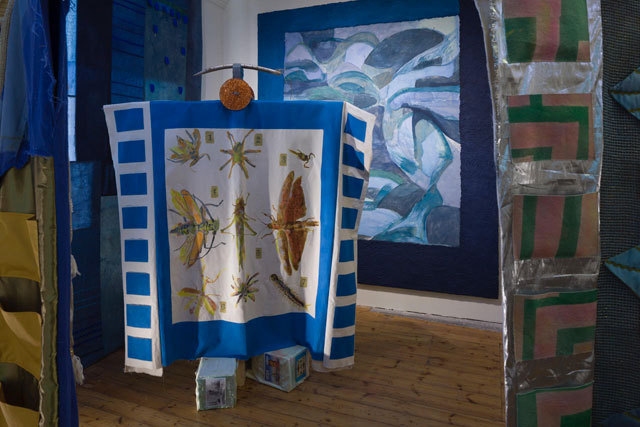
Tamara Henderson. Seasons End: Out of Body, 2017. Installation view at Serpentine Park Nights, London. Courtesy of the artist and Rodeo, London. Photograph. Hugo Glendinning.
RM: Was your performance Seasons End: Out of Body at The Serpentine in 2017 your first performance?
TH: Yes – it was my first experience of going into a space where there is someone else looking besides myself, where there are more eyes around. I’m often a hermit! In that performance, I was also the camera. I shot probably two rolls of film, maybe less, and that footage is in the Seasons End: Out of Body film that I finished in March 2018 for a screening at Tate, which was the first time I showed it.
RM: Can Seasons End be described as a series? It unfolded over a number of exhibitions and events, and included characters who migrated between locations and changed along the way. The main character is a scarecrow who passes through a cycle of health, sickness and eventually cremation.
TH: I think of that work as a short life cycle: the scarecrow’s life. The character emerged during a residency at Hospitalfield in Arbroath, Scotland. I had previously started to make the costumes in Istanbul, and they developed alongside the scarecrow in Arbroath. I showed them together at Glasgow International 2018, and then, when they moved to REDCAT gallery in LA, the scarecrow was sick, so we laid her down and built a bed and the character of “The Doc” was introduced. The Doc was by her bedside, there was a system of water feeding her drips, and clay was applied to her body. Basically, we burned that sculpture – we transformed that 4-metre long object into ash. It was quite an experience: we took apart the scarecrow while the exhibition was still up, dragged the body into a pickup truck, drove it to these fire pits on the beach by the airport, burned it and then collected the ashes in silver containers.
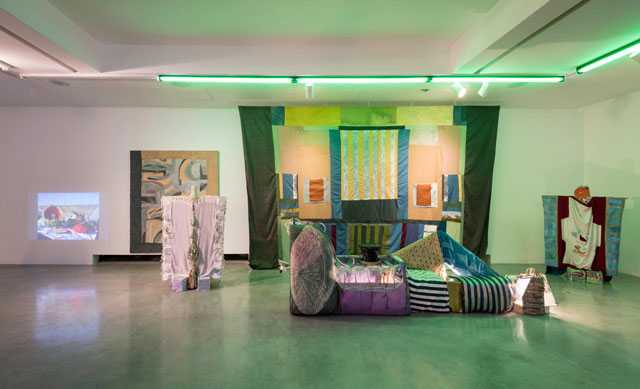
Tamara Henderson. Seasons End: Panting Healer, 2016. Installation view at Rodeo, London. Courtesy of the artist and Rodeo, London. Photograph: Plastiques.
There are big fire pits by the airport where we wouldn’t get in trouble burning things. The director at REDCAT brought her children, so they were playing happily around the fire. Interestingly enough, we have the scarecrow’s ashes here at Cass. You can use ash from cremation as a ceramic glaze, so we are trying to use a glaze made from her ash on a couple of the pieces.
RM: What happened to the scarecrow after you cremated her?
TH: I had a show that opened in March 2018 at Douglas Hyde Gallery in Dublin, and all 50 costumes were on show. There was also a new character in that show who had a box full of the scarecrow’s ashes in her belly. She is digesting the ashes, she’s processing them, and there’s a piece of paper that perpetually rolls through her on a motor that becomes more and more coded with the ashes. She also has a water system, which is kind of like the urinary tract, that emits a moth repellent.
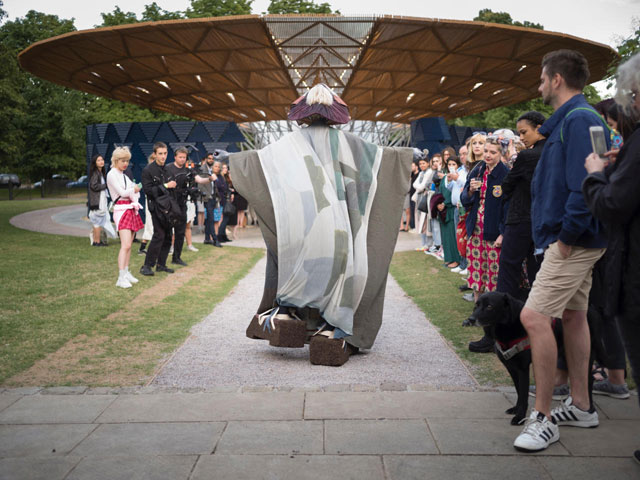
Tamara Henderson. Seasons End: Panting Healer, 2016. Installation view at Oakville Galleries at Centennial Square. Courtesy of the artist and Rodeo, London. Photograph: Toni Hafkenscheid.
RM: Why moth repellent?
TH: So much of the work is textile! I once saw a moth in the gallery, and a woman gave me a moth repellent recipe that had around 10 ingredients in it. I got an apothecary to mix it up, and then I dropped the tincture into the water system. After that, we didn’t see any moths. Some of the textiles were also my mother’s – things she had hand-sewn when she was my age.
RM: Do you see the work you are making at Cass as an extension of Seasons End, or is that period finished for you now?
TH: I feel like I opened up a new book after the Douglas Hyde Gallery. It was a great experience to have the 50 costumes there and to see the works all together, and I felt ready to let go of that process. For me, it was also my own mourning process. After my mum died, I started working on The Scarecrow’s Holiday (2015), and then I worked on Garden Photographer Scarecrow (2016), then I worked on the costumes. It was a process of flushing things out, and, while that process can never be over, there’s definitely been a transformation, a coming to an understanding.
This new work also steps out of textiles: it’s not work that you can fold up and put in a suitcase. My show at Douglas Hyde Gallery was called Seasons End: More Than Suitcases. I used to have this running epitaph joke with a friend: what would be on your gravestone? He said that mine would say: “Tamara Henderson, more than suitcases.” I thought it was so good. He said that years and years ago, but when it came time to make this show it was also time to make the epitaph. I’m also much more rooted in myself and staying in the same place longer.
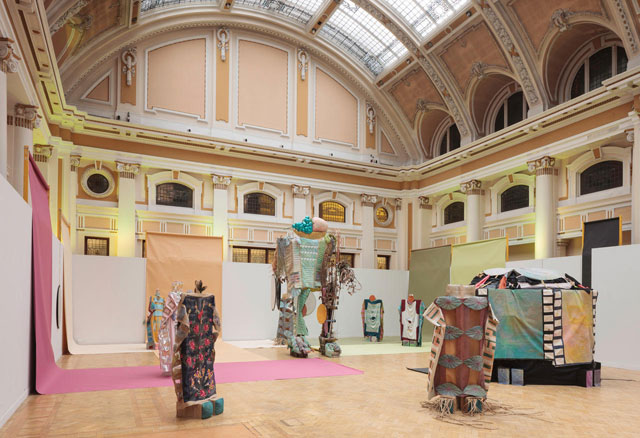
Tamara Henderson. Seasons End: More Than Suitcases, 2018. Installation view at The Douglas Hyde Gallery, Dublin. Courtesy of the artist and Rodeo, London. Photograph: Denis Mortell.
RM: You often work through residencies, which means you are constantly moving.
TH: It’s how I’ve travelled in my life: residencies and gallery shows. When I arrived at REDCAT and Douglas Hyde Gallery, I came with many suitcases! I never really had a studio after I finished school. For 12 years I was constantly moving. Now I’m based in London, where I’ve been staying for a long stretch of time. Coming to Cass, and this whole kiln experience, feels like coming to a different planet. It’s nice to feel you can travel without going anywhere. That’s something that interests me now, and it doesn’t require having your passport stamped.
• Tamara Henderson’s new body of sculptures will be on show at the Geneva Biennial of Moving Image from 8 November 2018 to 3 February 2019.